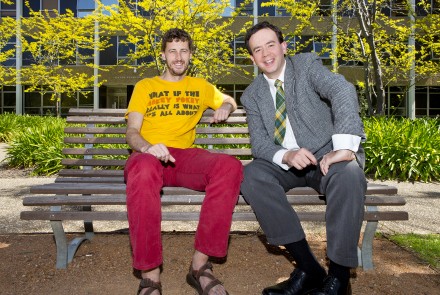Prime time

Photo (L-R): Dr Scott Morrison and Dr Timothy Trudgian
This time instead of ancient Greeks crunching the numbers, wiki-paging, blogging mathematicians began to set their minds to the problem.
Just as there are infinitely many numbers, there are infinitely many prime numbers. These primes, divisible only by themselves and one, have intrigued mathematicians for more than 2,000 years.
Ancient Greek mathematician Euclid asked whether there are infinitely many prime numbers only two numerals apart. The answer is still beyond the mathematical techniques we have today, so mathematicians are working on the next best thing.
“The prime gap problem we are working on now is to find a number N, such that you can guarantee that there are infinitely many pairs of primes the distance between which is, at most, N,” explains Mathematical Sciences Institute (MSI) researcher Dr Timothy Trudgian.
Earlier this year, University of New Hampshire lecturer Dr Yitang Zhang published a paper showing the number was indeed finite, putting it at 70 million. Prime numbers again became a hot topic.
However this time instead of ancient Greeks crunching the numbers, wiki-paging, blogging mathematicians began to set their minds to the problem.
Trudgian was one of the first out of the gate, tweaking the last few lines of Zhang’s working.
“I got it down to a shade under 60 million,” he says.
Down the hall, fellow MSI researcher Dr Scott Morrison saw Trudgian’s offering and got it down to 59.5 million, before teaming up with UCLA mathematician Terence Tao and slashing the number to 4.8 million. Morrison published his contributions on a blog he wrote with his graduate school colleagues.
“The fact there was a blog post with an open comment field enabled people who were interested in the problem to start throwing out some ideas,” says Morrison.
Eventually this conversation evolved to become a fully- fledged polymath project where mathematicians openly brainstormed solutions online.
Mathematicians all over the world began refining Zhang’s work line by line, posting up to 25 improvements each day to the polymath wiki.
“Polymath projects are cool because there is an explicit allowance to be wrong, which is somewhat unusual for mathematicians,” says Morrison.
As the prime gap problem naturally segments into several smaller problems, mathematicians were able to work independently on different sections, making incremental improvements.
“There are very few problems you can do this with in mathematics,” says Trudgian. “It was, if not unique, certainly different from the norm. The wiki, the fact you had people from different time zones all over the world working in their own time – it was great.”
Today, the prime gap is down to 4,680; new contributions have slowed and a paper is being written detailing the results of the project.
And, keeping in line with the collaborative nature of the project, the paper is of course available online.
